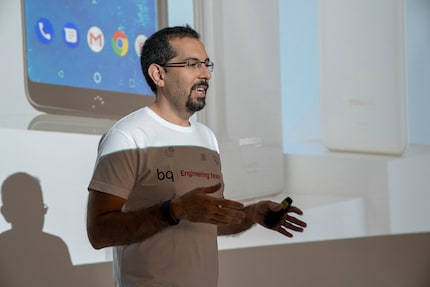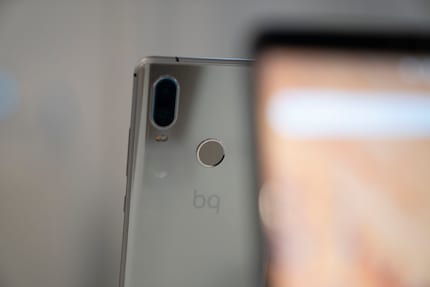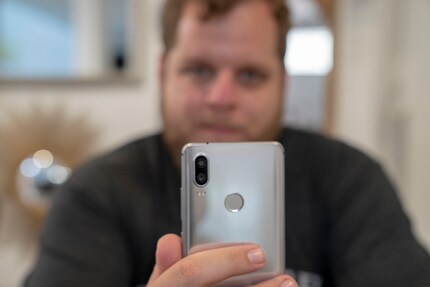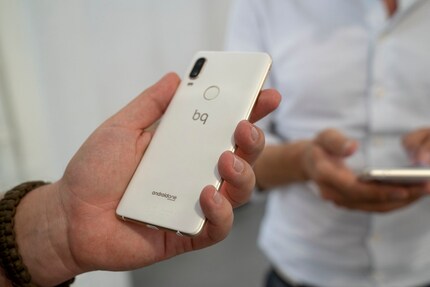
News + Trends
The first report from Munich: First contact with the BQ Aquaris X2
by Dominik Bärlocher
Spanish brand BQ presented its new flagship product in Munich. The BQ Aquaris X and X2 Pro aim to conquer the mid-range category. A first glance shows that they are already well ahead of the pack.
The Weststudio, in Munich. The new BQ Aquaris X2 and its big brother, the X2 Pro, are presented to the public. We're on hand to find out more about this brand, which ranks third in the Spanish smartphone market. It caused quite a stir last year in Spain at Mobile World Congress with its Aquaris X and X Pro. In Germany too. The X2 series is now continuing its conquest. Its target? Europe.

Ravin Dhalani, CTO and co-founder of BQ, presents his new features himself. We will understand during the conference that hardware is not the only important element. The brand attaches great importance to security and privacy. It prides itself on developing all the components - bootloader, hardware and design - in Madrid. Mr Dhalani is wearing a white T-shirt bearing the BQ logo and the words 'Engineering Team'. He stands in front of the media, visibly proud of his products.
"We prohibit the development of our devices outside our headquarters in Madrid," he says. Parts are bought - mostly from Qualcomm and other major chip manufacturers - but they are carefully scrutinised.
The philosophy behind the BQ Aquaris X2 series is simple. "We've improved every detail," says Dhalani. Sound, picture, battery capacity, performance. However, the devices shown at the event are not yet the final versions. The camera still needs to be modified, and other final details are still being worked out. However, the smartphones already impress us when we first hold them in our hands.

The X2 weighs in at just over 150g. It is equipped with a Snapdragon 636 system on a chip (SoC) from Qualcomm, which translates into high performance for little software. In fact, BQ is banking on a partnership with Google. Both the X2 and its big brother, the X2 Pro, run Android One. I'll tell you more about that below.
"We started by developing the screen," Dhalani tells us.
With 650 nits of brightness, 2.5D glass - a curvature that forms what's known as an Infinity screen - a 5.65-inch screen and Quantum Color + technology. The colours don't reach those of an AMOLED phone, but BQ clearly didn't just make a screen.
Reporters took note. Mr Dhalani spoke with pride and passion, even when the beamer on which he gave his presentation momentarily failed him. Since BQ also makes other household appliances, he quipped, "maybe we should start making beamers."
When Mr Dhalani talks about his phone's camera, it's clear that he's not just a marketing executive with a message to get across. The dual lens settings have been a problem for him, and he tells us all about it with all the skills of a nerd.
"We didn't want to add a dual lens until we were sure that the sensor or other components weren't reducing image quality."
The image sensor comes from Samsung. It is the S5K2L8. Such candour is rare at press conferences. The phones are also equipped with an image stabiliser from VidHance, a Swedish company.
The image stabiliser is from VidHance, a Swedish company.
The image stabiliser is from VidHance, a Swedish company.
After hours of testing, Ravin Dhalani and his team were finally confident they could do it.
So they equipped the X2 and X2 Pro with the same cameras and the same sensor. The dual lens can produce a bokeh effect, i.e. a good depth of field. The camera also has a strange 'Beauty' mode that beautifies you. Mr Dhalani referred to the bokeh effect as 'bokeh mode' and 'portrait mode', before pulling himself together and telling us: "Well, call it what you like". As for the software, it's called 'portrait mode'.

BQ hasn't forgotten about selfie mode. Even though the camera's front sensor only reaches 8 megapixels, it's not junk. "We've invested money in it because it's an important feature for our users". Always that uncharacteristic frankness that betrays the nerd in Mr Dhalani...
The front sensor also supports portrait mode, even though the front of the camera doesn't have two lenses. The rear lens achieves a bokeh effect by stitching two images together, while the front lens uses artificial intelligence. "We left deep learning technology on the front lens, that's how portrait mode works." The algorithm takes thousands of images and deduces how the image should look. It was developed by a Spanish university.
The presentation becomes even more captivating. Mr Dhalani shows us a screenshot of the camera application. It looks exactly like the Google application, but with the new features the technical director is showing us, it's almost impossible for it to be a Stock application (imposed by Google). On closer inspection, we also notice that the camera icon is white, rather than grey like the Google icon. The camera does, however, incorporate everything that Google provides, including Google Lens. This feature has not yet been finalised; it should be very soon, our speaker assured us.
He is proud of his brand. "Those who watched Google I/O yesterday also spotted our logo among the big names. We're honoured by that."
I want to believe him, because he can talk for hours about his phone. He's as funny as he is enthusiastic. That, too, is rare at press events.
The main difference between the two phones is their different system on a chip (SoC).
"We don't like artificial tests, but consumers do," says Dhalani, showing us an Antutu Benchmark score of over 143,000. He rounds it up to 150,000 with a laugh.
Since Ravin Dhalani has so much to tell us and knows how to captivate his audience, I'll quickly list the rest of the features:
"Why are so many manufacturers doing away with FM radio?" is more of a rhetorical question. "I can tell you this: radio makes the phone's audio track a lot more complicated," because the headset acts as a receiving antenna. With FM radio, the whole audio system has to be arranged differently. And given the size of a smartphone, especially one with a large screen, the quality can be diminished.
BQ is one of the first manufacturers to bet entirely on Android One. So no software development would be needed in-house if Mr Dhalani and his team weren't ambitious.
Designed by Google. Smart, secure, and simply amazing.
The short version: Google has created a lighter version of Android than the classic version. It should at least allow access to current patches on cheap, low-performance devices from developing and emerging countries.

At the same time, the industry has been grumbling for a long time, because Android ROMs (modified versions of the original software) such as Samsung's, are allegedly not providing their updates and security patches quickly enough. Clever people were quick to seize the opportunity, and Android One, the third-world version of Android, has attracted widespread interest. It contains no superfluous features, no changes, just the essentials. And above all, users receive regular updates.
Android One therefore got its own department at Google, and became the new project for manufacturers like BQ. The third-world Android is now called Android Go (in English) and wants more than ever to impose the very latest standards on underperforming phones.
However, it also has its faults. When a manufacturer bets on it, they get the latest security patches - BQ's devices work with the May 2018 patch - and a state-of-the-art Material Design 2 redesign, but they also have to hand over the controls. Data is passed to Google more or less uncontrollably, and any regulation remains limited.
In short, if the American company had limited its implications in the past, it now acts with much more firmness, uniformity, control, and has become much more powerful as a result.
Google's philosophy is not meaningless, however. Manufacturers - especially Samsung - are in no rush to accommodate updates, patches and upgrades. The situation has certainly improved recently, but with a one-year innovation cycle, updating a two-year-old device and supporting all the hardware and software interfaces isn't really worth it. There's not much point in tying up developers who should be working on the next product. Manufacturers think it's still relevant, but Google doesn't. Why should it release one new version of Android after another, if smartphone manufacturers are months or even years behind simply because they can't make dumb changes?
That's why Android One is a seamless software package, not a third-world version of the software. It offers regular updates and upgrades, good performance, and Google can guarantee security standards. What's more, manufacturers save money because they don't have to deal with software development.
Google has failed to come up with a new name for its dedicated development department, which again shows how much trouble the company has naming its software. Typical.
One trend became clear during yesterday's keynote at Google I/O: Google would very much like manufacturers to upgrade their phones to be compatible with Android P. Could this mean that Android One users will get access to Android P sooner? Google officials are still keeping a low profile, but if the company supports its own software and integrates it into devices, it's not hard to imagine that Android One users will receive the latest version of Android directly after its launch.
BQ isn't just buying Android One, it's also contributing to its development. "It's an honour, and it makes us..." - Mr Dhalani hesitates to use the adjective "proud" - "...very happy". As one of Google's selected partners, BQ takes its findings seriously. Partners have to meet a number of conditions and be as innovative as they are daring. Mr Dhalani finally lets out a "proud".
Ah, and BQ promises "two-letter upgrades" and monthly security updates. A one-letter upgrade is when you go from Android O to Android P to Android Q. Samsung rarely manages this.
What about the market, in all this? BQ is certain it can position itself on the European market. With an aggressive pricing policy. Mr Dhalani, however, interrupted the discussion on pricing. To sum up, BQ offers the same performance for the same price as Honor. In other words, lots of features for very little money. And opts for silver-grey. "We've incorporated the colour into the glass, which we've never done before."
This aspect seems to concern him, as he interrupted his particularly relaxed presentation on two other occasions to remark on this colour..
I didn't want to deny myself a closer look at the silver-grey colour. My summary: it's not as spectacular as the twilight on the Huawei P20, but it's worth a look.
"You know, your opinions are very important," Mr Dhalani tells us, "because we are a European manufacturer aimed at the European market."
The Android One security concept was presented to media representatives at a workshop placed directly after the presentation. It was to have been held in German, but Mr Dhalani interrupted it when the discussion turned to Treble.
In the Android system, Treble defines a fixed interface between the hardware and the Android framework. It sits on top of the kernel and forms the Hardware Abstraction Layer or HAL. The kernel and HAL form the framework. When Treble is integrated, the time it takes to configure the hardware when upgrading to a subsequent version of Android takes much less time.
Ravin Dhalani takes the opportunity to give us some insider information. In English. He talks about launcher, update policies, gives us an overview of the market and makes us laugh.
Journalist. Author. Hacker. A storyteller searching for boundaries, secrets and taboos – putting the world to paper. Not because I can but because I can’t not.
From the latest iPhone to the return of 80s fashion. The editorial team will help you make sense of it all.
Show all